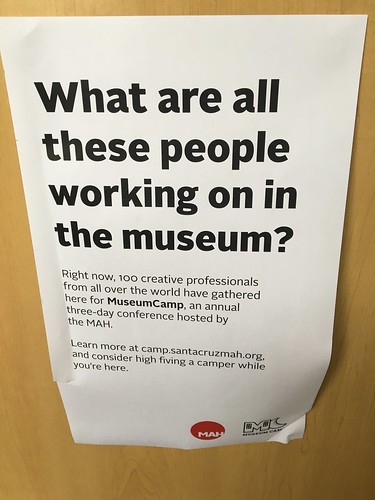
Last week I was honored to be a counselor at Museum Camp, an annual professional development event hosted by the Santa Cruz Museum of Art & History (MAH). Each year they bring together diverse, passionate people for a sleep-away camp for adults where they learn together through active, creative workshops and activities. Since the theme this year was “Change Making,” I taught a workshop on self-care for change makers based on my forthcoming book, The Happy Healthy Nonprofit, co-authored with Aliza Sherman.
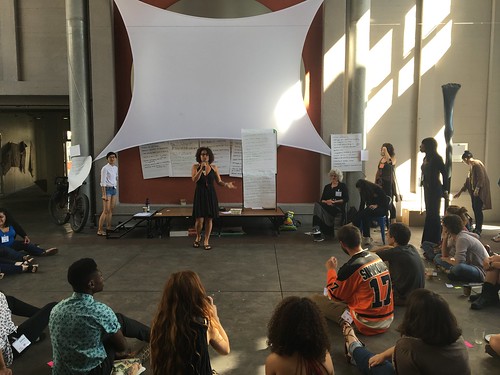
Nina Simon, the executive director of the museum, is an expert in participatory design and fantastic facilitator. It was great to watch her in action facilitating the creative, interactive, and fun program. The culminating project was for teams of campers to design and create a “zine,” on change making topics. Before the workshops, they facilitated a brainstorming and collaborative voting process to identify topics and teams.
Throughout the camp, anyone could drop a suggestion for a topic into the Zine Topic Suggestion box – people gathered in the large entry way of the museum to read the topics and contribute their own. We filled 8 flip chart pages with close to hundred ideas. The next step was to whittle it down to 20 topics by voting using an applause meter.
An applause meter is just what you think it is. People voted by clapping. The loudest clapping meant the idea was in the group of twenty. They were even somewhat scientific about it by creating a scale. To create the scale, they first asked the whole group to applaud for an idea they “sort of liked.” Next, to applaud an idea they liked and finally an idea they were wildly excited by. One of the counselors did a visual of the meter. Here’s a quick video.
I like this alternative to sticky dot voting! After the winning 20 ideas were selected, each idea was posted on a separate piece of paper on the walls. Each camper had three sticky notes where we added our names. Then we placed our sticky notes on the ideas we were most interested in working on. Everyone went into the various workshops and after the workshops the assignments — the twenty teams, each an assigned to a topic were announced. Teams worked on their zines until the end of the camp.
The Happy Healthy Social Change Activist: Passion for a Cause without Burnout Workshop
As a trainer in the nonprofit sector for past 25 years, my book writing naturally leads to new curriculum for professional development of nonprofit professionals. I was thrilled to be able to pilot a new workshop based on my forthcoming book, “The Happy Healthy Nonprofit: Impact without Burnout” This mini-workshop was for individual change makers working solo (free agents) or with small or midsize nonprofits.
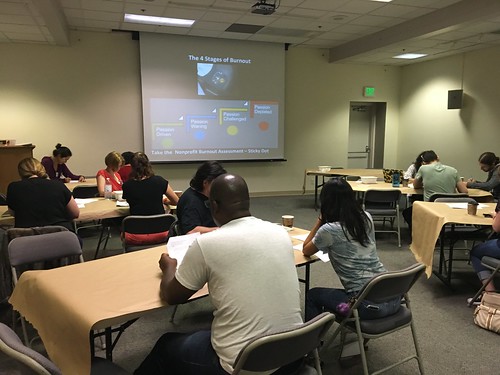
In the book, we discuss the many reasons for burnout in the nonprofit sector, but more importantly how to identify the symptoms because burnout can be very sneaky. We came up with a passion scale — from Passion Driven, Passion Waning, Passion Challenge, and Passion Depleted. The assessment helps educate people about the symptoms of burnout before it becomes too late. Next we did a series of small group exercises for participants to identify their stress triggers and reactions to stress.
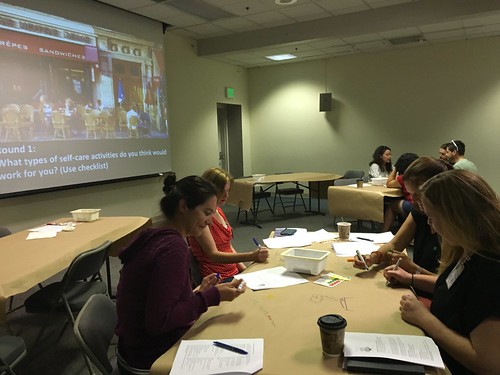
Next, I had participants review an inventory of ideas around self-care practices. Self-care has to be customized to the individual – they have to design their own adventure or it won’t work. We set up a “self-care” cafe where small groups of participants discussed self-care ideas and draw them on the table (well on butcher paper). A few interesting themes came up ….
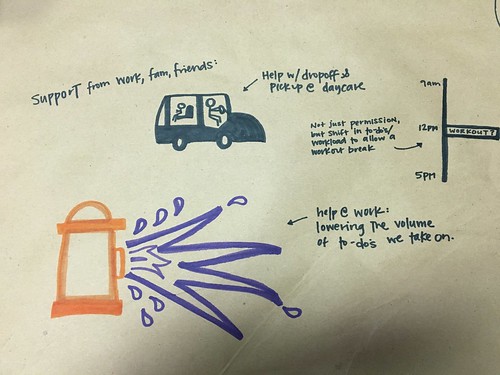
Asking for Support, Mini-Breaks, and Prioritizing
Many activists get into a mode where they feel they have to do it all or that everything is important on the to do list. This is more a mind shift than anything else. It is about learning how to prioritize tasks and understanding your personal limits, Not every task is a 10 on the scale. Another idea that bubbled up, was the concept of mini-breaks during the work day to replenish energy. And, of course, asking for or receiving help from family and friends.
Don’t Isolate Yourself From Friends, Family, or Professional Peers Who Give You Energy
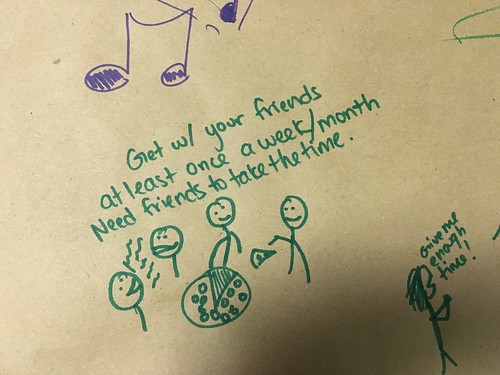
Sometimes activists dedicated so much of themselves to a cause, that they become isolated from family, friends, and peers who give them energy. Several participants reflected on how it is easy to fall into that trap and looked at beginning to schedule more time with people to build relationships that give them inspiration and energy.
Being Intentional About Your To Do List
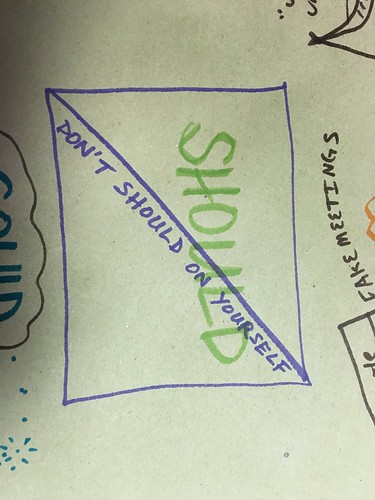
I don’t think I could have explained this better than this “Don’t Should on Yourself.” Sometimes we can create more stress for ourselves if we think that we need to do everything on our list. A lot of list is being able to say no. It is also about not feeling guilty about not doing a task.
This One Was A Joke, But Still ..
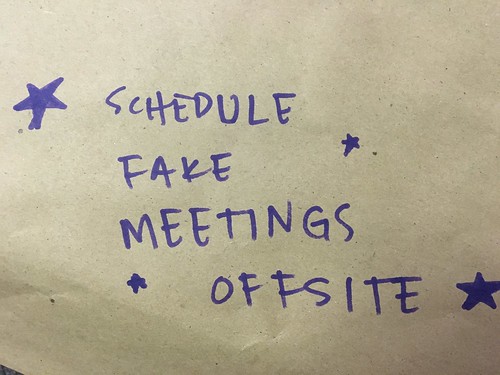
This was not a serious suggestion and was a joke, more or less. The story was that an organization had hired a consultant who scheduling meetings with staff but was not showing up. So, the joke at the office was, if you need downtime, schedule a meeting with the consultant. Actually scheduling fake meetings off-site, it is lying.
When I posted this on my Facebook wall, it prompted some discussion points. Jeremiah Owyang said, “This is unethical and it’s worth firing somebody for. It’s also a sign that the employee and the manager are not setting a good culture of work life balance. A mature employee knows how to manage up. This is a Band-Aid, not addressing the main problem.” It might suggest the need for professional development in teaching skills of up managing or being more assertive.
Hildy Gottelieb pointed out, “I’d love to explore what it would take for systems to be so human that no employee would ever have to figure out ways around it just to be able to breathe.” It is an organizational culture issue or perhaps people-centered leadership approach.
More and more nonprofits are experiencing “Collaboration Overload,” back to back meetings or an overflowing email in-box. This means there is little down time for reflection and thinking. With so many demands, it is harder and harder to carve out that time without overworking. While individual communications skills to “manage up,” it is also an organizational culture issue.
How does your organization ensure that employees have adequate work/life balance, peak productivity, and nurture a support of wellbeing, not stress?
Beth Kanter is a consultant, author, influencer. virtual trainer & nonprofit innovator in digital transformation & workplace wellbeing.

Leave a Reply